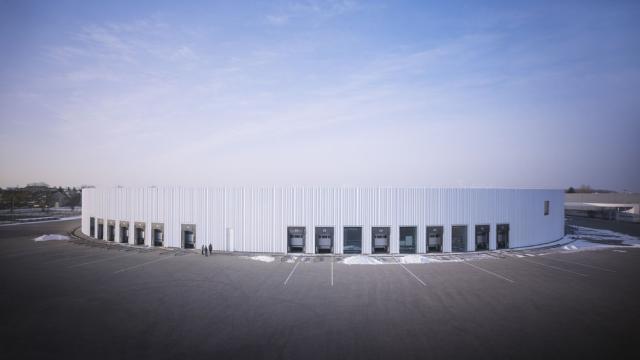These days, most of us expect the things we buy online to arrive within a day or two. After all, why does ecommerce exist, if not to deliver a horse head mask to my doorstep within 24 hours?
To meet our expectations, companies are employing an increasingly unconventional set of solutions to function more efficiently, from Amazon buying the robotics company Kiva to Fab opening up its own network of fulfillment centres. But one of the most important changes might be entirely rethinking the factory as we know it.
Last week Vitra, the German furniture manufacturer, unveiled its latest assembly and shipping centre. And it’s certainly unconventional. The 5500sqm factory, designed by the Japanese firm SANAA (of New Museum fame), is circular. Actually, it’s not quite circular; in accordance with the Japanese principle of wabi sabi, which seeks beauty in imperfection, it’s a slightly off-centre spline knot.
At first glance, a 146m wide circular factory is a logistical nightmare (or joke). Industrial buildings are rectangular for a reason; it’s the most efficient use of space, and orthogonal boxes are cheaper and faster to build than abnormal curves. But according to the architects, there’s a very good reason for Vitra to build in circles:
This proposal, which at first seemed unusual, was based on the realisation that logistics and production methods no longer adhere to strictly hierarchical principles, but require flexibility… Although Vitrashop primarily utilizes standard components in the interiors that it creates for retail and commercial customers, the elements are customised to suit the specifications and desires of the individual clients. This contradicts a strictly linear flow of goods and fabrication methods.
At the Vitra factory, raw goods are delivered at an array of docks at the north end, where they’re categorised and shelved in the first staging area. Then, workers select the components and transport them to the central assembly area. Then, the finished products are organised in the zone below the assembly floor. Finally, finished orders are shipped from an identical array of loading areas that face south. The idea is that each order might require objects from all over the facility, so a circular circulation path shortens the distance between any two zones, as Vitra’s reps explain:
The circular footprint of the building permits the delivery and loading of goods in completely different locations, so that the flow of traffic inside the hall is reduced, optimised and simplified. The assembly zone in the middle of the building can also be variably configured to meet new requirements based on current orders.
In logistics speak, this is called macroflow, or the flow of materials as they enter, are processed, and leave a particular facility. “Industries have attempted to create efficient plant layouts since the dawn of industrialisation,” write the authors of one study on distribution centre design. “[But there’s no] set methodology that can be repetitively applied to all plant layout exercises so that they turn out as the most efficient plant layout. In this sense, creating of plant layouts is more of an art than a science.”
The Vitra factory is heavy on the art, but it also makes a certain amount of sense for a company that deals in giant shipments of prefab and made-to-order systems. It’s unlikely that we’ll see a lot more circular assembly centres, but it’s worth noting the R&D many companies are pouring into assembly and shipping. It’s been a long, long time since anyone rethought how factories should be shaped — most of the focus has been on systems inside. But when seconds count, every aspect of the shipping process can become a tool to drive efficiency, right down to the architecture.
